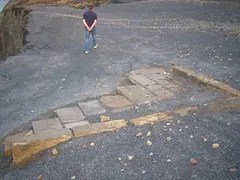Loftus Alum works began operation in the 1650’s and ran until the 1860’s and cover roughly half a mile on a quarried shelf below the cliff. Alum is a mordant for fixing dyes to cloths.


The quarrying process has left large sandstone cliffs at the back of the quarries


The quarries themselves are still barren with little vegetation ever having returned to the slopes.




After quarrying the alum shale was burned for many months in large mounds called clamps, a process called calcining. Areas of burned red shale can be seen on the site, although its possible these are from natural fires at a later date rather than clamps.

There are the remains of several steeping pits, where the burnt alum shale would then have placed in water to dissolve the alum salts, these are rapidly nearing the cliff edge and will erode away in a few years time.


Carved stone troughs can also be found which would have transported liquids around the site.

The alum liquor would have been transferred into a tank or cistern to allow any particles to settle out, a double walled circular cistern can be still be seen protruding from the edge of the cliff.

The settled liquor would then have been transferred to the Alum House where it was concentrated by evaporation until a specific concentration was reached, said to be the point where an egg would float in it. Akali (usually kelp or urine) was then added and the alum crystals formed as the liquid cooled.
 Show on map
Show on map

























































